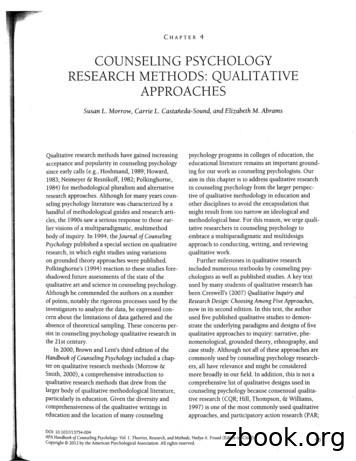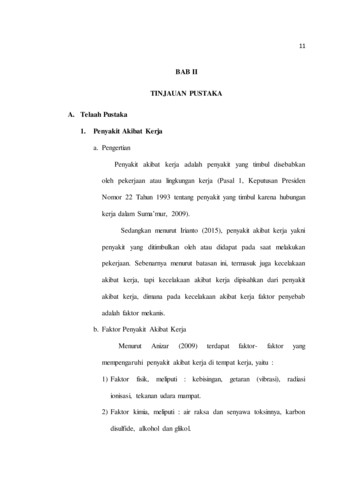Introduction To QCAmap - Qualitative Content Analysis
Introduction to QCAmapPhilipp MayringUniversity of Klagenfurt and ASQ2020
Introduction With a series of slides we wouldlike to show you the basicprocedures of the software.The program entry page(www.qcamap.org) The Website with further infos(www.qualitative-content-analysis.aau.at) Informations about first steps toget startedYou need to register an account.We guarantee that all your datawill be kept confidential. A registration notification will be sent toyour email-address (green button).Then you can user the softwarefrom everywhere using differentwebbrowsers (Internet Explorer 9,Mozilla Firefox, Google chrome).Since the application is web-basedyou will always work with thelatest version of the program.
Starting your work First you have to create a newproject (title and description)Then you have to define a researchquestion and description!Then you chose the contentanalytical technique (currently,inductive category formation and deductivecategory assignment are available)! If you chose a technique from thepulldown menue the programgives you a link to the proceduralmodel and analytical rules, and itgives you the specific template.You should give a description ofthe research question!By pressing „Save changes“ theprogram will save your researchquestion and leads you to the nextsteps.
Research Question(s)This is a sceenshot of a researchquestion working with inductivecategory assignment.Content analytical rules (coding unit,recording unit, context unit) aredefined.In inductive category assignment aselection criterion and a level ofabstraction have to be defined.
Mandatory fieldsIf you have forgotten to specify theunits of analysis or the techniquespecific rules the program stops youand gives you an error message!
Upload your text material For each research question youhave to upload the text documentswhich will be analyzed! Be shure to have anonymized yourmaterial!
Now you can go into thecoding mode On the left side all contentanalytical definitions and rules ofthe specific technique (in this caseinductive category formation) arekept.You can mark (mouse) textpassages.Then the list of inductivecategories so far developped ispresented. You can subsume thetext passage to one of them orcreate a new inductive category.
Deductive categoryassignment Here again the specificrules and definitions arepresented at the left side.On the right side th codingguideline, containingdefinitions, anchorexamples and coding rulesfor every deductivecategory is displayed.Marking text passagesgives you the possibility toassign it to one of thepreformulated categories.After coding a certainamount of material theprogram reminds you torevise the category systemand the coding guideline(pilot phase). Afterfinishing the pilot phase,no more changes can beapllied to the codingguideline.
Multiple Features You can simultaneously work withseveral questions (for exampleinductive and deductive) in oneproject with the same material.You can share your analysis withather persons (who are registratedin QCAmap).You can test intra- and intercoderaggreement.Do not forget to log out at the endof your session.Enjoy the program!
Introduction to QCAmap Philipp Mayring University of Klagenfurt and ASQ 2020. . recording unit, context unit) are defined. In inductive category assignment a selection criterion and a level of . Be shure to have anonymized your material! Now you can go into the coding mode
Introduction With a series of slides we would like to show you the basic procedures of the software. The program entry page (www.qcamap.org) The Website with further infos (www.qualitative-content-analysis.aau.at) Informations about first steps to get started You need to register an account. We guarantee that all your data
Qualitative Analysis of Anions 1 Experiment 10 Qualitative Analysis of Anions Pre-Lab Assignment Before coming to lab: Read the lab thoroughly. Answer the pre-lab questions that appear at the end of this lab exercise. The questions should be answered on a separate (new) page of File Size: 343KBPage Count: 16Explore further(PDF) Experiment Report: Analysis of Anions and Cations .www.academia.eduExperiment 7 Qualitative Analysis: Anionswww.csus.eduLab Experiment #8: Qualitative Analysis of Common Anions .www.youtube.comQualitative Analysis of Anions - Odinitywww.odinity.comLab 13 Qualitative Analysis of Cations and Anionsdoctortang.comRecommended to you b
ter on qualitative research methods (Morrow & Smith, 2000), a comprehensive introduction to qualitative research methods that drew from the larger body of qualitative methodological literature, particularly in education. Given the diversity and comprehensiveness of the qualitative writings in education and the location of many counseling
qualitative data. (Note that pure qualitative research will follow all of the paradigm characteristics of qualitative research shown in the right column of Table 2.1.) Mixed research – research that involves the mixing of quantitative and qualitative methods or paradigm characteristics. The mixing of
1. Explain what qualitative methods can add to program evaluation and identify situations/reasons when qualitative methods may be appropriate. 2. Identify different types of qualitative evaluation data collection and analysis and list steps involved in doing them. 3. Apply best-practices for qualitative methods in relation to program evaluation.
The relationship between qualitative, quantitative and mixed methods research. The importance of the research question in an analysis. The need for methodological rigour in qualitative research. 1.1 Qualitative, Quantitative – A Few Clarifications What do the terms ‘qualitative data’ and ‘quantitative data’ mean? While the
Qualitative Analysis of Group I Cations – The Silver Group 2 temperature of the solution increases from 20 C to 100 C. The solubilities of AgCl and Hg 2Cl 2 increases very little over this temperature range. Thus, PbCl 2 can be separated from the other two chlorides by adding hot water.File Size: 287KBPage Count: 9Explore furtherExperiment 12: Qualitative Analysis of Cationswww.bc.edu6: Qualitative Analysis of Group I Ions (Experiment .chem.libretexts.org18.9: Qualitative Cation Analysis - Chemistry LibreTextschem.libretexts.orgSeparation and identification of cationswww.periodni.comOxidation numbers calculatorwww.periodni.comRecommended to you b
Walaupun anatomi tulang belakang diketahui dengan baik, menemukan penyebab nyeri pinggang bawah menjadi masalah yang cukup serius bagi orang-orang klinis. Stephen Pheasant dalam Defriyan (2011), menggambarkan prosentase distribusi cedera terjadi pada bagian tubuh akibat Lifting dan Handling LBP merupakan efek umum dari Manual Material Handling (MMH). Pekerja berusahauntuk mempertahankan .























